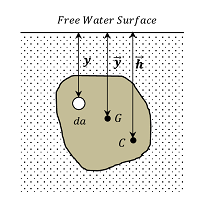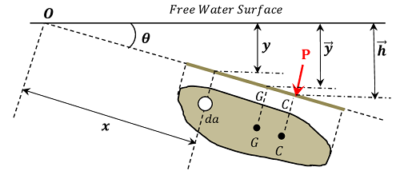What is called centre of Hydrostatic pressure?
The point at which the resultant hydrostatic pressure acts on the immersed surface is called centre of pressure.
- The intensity of pressure is not uniform at all points on a vertical immersed surface or inclined immersed surface.
- It depends upon the depth of the point below the free liquid surface. As the depth of surface increases, the pressure intensity also increases.
- Hence, the resultant pressure act at a point C which always lies below the centroid G of the surface.
- This point is called the centre of pressure.
Centre of pressure of immersed surfaces
Intensity of hydrostatic pressure at a point on an immersed surface depends upon the depth of that point below the free liquid surface. As the depth of point ( \bar {h} ) increases, the pressure intensity ( p ) also increases.
Therefore, intensity of hydrostatic pressure –
p \ \propto \bar {h}
Therefore, following conclusions can be made –
In vertically immersed surface –
- Average pressure intensity on the area below a horizontal line passing through centroid of the surface will be more as compared to the average pressure intensity on the area above that line.
- Therefore, the centre of pressure ( C ) of a vertically immersed lamina always lies below the centroid ( G ) .
In inclined immersed surface –
- Due to similar reason, average pressure intensity on the area below a horizontal line passing through centroid of the surface will be more compared as compared to the average pressure intensity on the area above the line.
- Therefore, the centre of pressure ( C ) of an inclined immersed lamina also lies below the centroid ( G ) .
In horizontal immersed surface –
- Whole surface area lie at the same depth from the free water surface. Hence, average pressure intensity on the whole area is same.
- Therefore, the centre of pressure ( C ) of a horizontally immersed lamina coincides with the centroid ( G ) .
Centre of pressure of vertically immersed lamina

Consider about a vertically immersed lamina as shown in figure.
Let, ( \bar h ) is the depth of point C below the free water surface as shown in figure.
Consider about an elemental area ( da ) of the lamina situated at a depth of ( y ) below the free water surface.
- The total pressure force on the elemental area is ( w \ y \ da )
- Moment of this force about the water surface will be ( w \ y^2 \ da )
Therefore, moment of the total pressure on the lamina about the water surface will be –
\sum {w \ y^2 \ da} = w \sum {da \ y^2} = w \ I_0
But, ( \sum {da \ y^2} ) represents the moment of inertia of the lamina about the line of intersection of the water surface and the plane of the lamina. Let, it is represented by ( I_0 ) .
- Also total pressure on the lamina is –
P = w \ A \ \bar {y}
This pressure is acting at the centre of pressure C
- Moment of the total pressure about the free water surface will be –
P \ \bar {h} = ( w \ A \bar {y} ) \bar {h}
For equilibrium of the lamina –
( w \ A \bar {y} ) \bar {h} = w \ I_0
So, \quad \bar {h} = \left ( \frac {I_0}{A \bar {y}} \right )
= \left ( \frac {\text {Second moment of the area about the water surface}}{\text {First moment of the area about the water surface}} \right )
Let, ( I_y ) is moment of inertia of the lamina about the centroidal horizontal axis in the plane of the lamina.
By parallel axes theorem of moment of inertia, we get –
I_0 = I_y + A {\bar {y}}^2
Therefore, \quad \bar {h} = \left ( \frac {I_0}{A \bar {y}} \right ) = \left ( \frac {I_y + A {\bar {y}}^2}{A \bar {y}} \right )
= \bar {y} + \left ( \frac {I_y}{A \bar {y}} \right )
Centre of pressure of inclined immersed lamina
An inclined immersed lamina as shown in figure.

Consider about an elemental area ( da ) of the lamina at a depth ( y ) from free water surface. Force on the elemental area will be –
P = w \ y \ da = w \ da \ x \sin \theta .
This force acts normal to the lamina as shown in figure.
- Moment of this force about O is –
( w \ da \ y ) \times x = w \ da \ x^2 \sin \theta
- Therefore, moment of the total pressure about O will be –
\sum w \ da \ x^2 \sin \theta = w \sin \theta \sum da \ x^2 = w \sin \theta I_0
Here, ( I_0 ) is the moment of inertia of the lamina about the line of intersection of the plane of the lamina and free water surface.
Let, depth of the centre of pressure is ( \bar h ) .
So, distance of point C \text {from point} \ O = \frac {\bar h}{\sin \theta}
- Moment of the total pressure on the lamina about point O will be –
\text {Total pressure} \times \frac {\bar h}{\sin \theta} = w \ A \ \bar y . \frac {\bar h}{\sin \theta}
Therefore, \quad w \ A \ \bar y . \frac {\bar h}{\sin \theta} = w \ \sin \theta \ I_0
Or, \quad \bar h = \frac {I_0}{A \ \bar y} \sin ^2 \theta
Let, ( I_g ) is the moment of inertia of the lamina about centroidal axis in the plane of the lamina parallel to the water surface.
- Distance between the centroidal axis and the water surface is ( \bar y \cosec \theta )
By parallel axes theorem of moment of inertia –
I_0 = I_g + A ( \bar y \cosec \theta )^2 = I_g + A \bar y^2 \cosec^2 \theta
Substituting in the above expression for ( \bar h )
\bar h = \left [ \frac {I_g + A \ \bar y^2 \cosec^2 \theta}{A \bar y} \right ] \sin^2 \theta
= \bar y + \left [ \frac {I_g \sin^2 \theta}{A \bar y} \right ]
